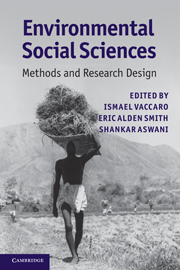Book contents
- Frontmatter
- Contents
- Contributors
- Foreword
- Preface
- 1 Introduction
- 2 People, numbers, and natural resources: demography in environmental research
- 3 Production decisions and time allocation: a guide to data collection
- 4 Analyzing the politics of natural resources: from theories of property rights to institutional analysis and beyond
- 5 Extreme events, tipping points, and vulnerability: methods in the political economy of environment
- 6 Local communities and natural resources: ethnobiology in practice
- 7 Mapping histories: cultural landscapes and walkabout methods
- 8 Metaphors and myths in news reports of an Amazonian “Lost Tribe”: society, environment and literary analysis
- 9 Water decision-makers in a desert city: text analysis and environmental social science
- 10 Linking human and natural systems: social networks, environment, and ecology
- 11 Khat commodity chains in Madagascar: multi-sited ethnography at multiple scales
- 12 Spatiotemporal methodologies in environmental anthropology: geographic information systems, remote sensing, landscape changes, and local knowledge
- 13 Deep time, diachronic change, and the integration of multi-scalar data: archaeological methods for exploring human–environment dynamics
- 14 Comparing trajectories of climate, class, and production: an historical ecology of American yeomen
- 15 Socioecological methods for designing marine conservation programs: a Solomon Islands example
- Index
- References
13 - Deep time, diachronic change, and the integration of multi-scalar data: archaeological methods for exploring human–environment dynamics
Published online by Cambridge University Press: 05 June 2012
- Frontmatter
- Contents
- Contributors
- Foreword
- Preface
- 1 Introduction
- 2 People, numbers, and natural resources: demography in environmental research
- 3 Production decisions and time allocation: a guide to data collection
- 4 Analyzing the politics of natural resources: from theories of property rights to institutional analysis and beyond
- 5 Extreme events, tipping points, and vulnerability: methods in the political economy of environment
- 6 Local communities and natural resources: ethnobiology in practice
- 7 Mapping histories: cultural landscapes and walkabout methods
- 8 Metaphors and myths in news reports of an Amazonian “Lost Tribe”: society, environment and literary analysis
- 9 Water decision-makers in a desert city: text analysis and environmental social science
- 10 Linking human and natural systems: social networks, environment, and ecology
- 11 Khat commodity chains in Madagascar: multi-sited ethnography at multiple scales
- 12 Spatiotemporal methodologies in environmental anthropology: geographic information systems, remote sensing, landscape changes, and local knowledge
- 13 Deep time, diachronic change, and the integration of multi-scalar data: archaeological methods for exploring human–environment dynamics
- 14 Comparing trajectories of climate, class, and production: an historical ecology of American yeomen
- 15 Socioecological methods for designing marine conservation programs: a Solomon Islands example
- Index
- References
Summary
Introduction
Over the past 25 years, the environmental science literature has increasingly affirmed that contemporary environments are a product of their long-term histories (e.g., Foster 2000). This growing realization in the ecological community has led to a corresponding interest in histories of human–environment interaction, and thus, archaeological data (Hayashida 2005; Kirch 2005). Archaeologists have long been interested in connections between environment and society; the subfield known as “environmental archaeology” is entirely devoted to this area of research. Environmental studies and archaeology are a natural fit: archaeological studies provide diachronic data on environmental change, and can be critical for evaluating claims of human response to or influence on these changes. Likewise, the focus of archaeology on the material components of human–environment interaction provides a perspective often missing in more ideological studies of society and environment. Archaeologists have long argued the relevance of archaeological data for environmental studies (Fritz 1973; Lyman and Cannon 2004; Wintemberg 1919); in recent decades, collaborations between archaeologists and environmental scientists have become increasingly common (Burgi and Russell 2001; Schimmelmann, Lange, and Meggers 2003). Current areas of interest within archaeology, such as niche construction (Banks et al. 2008; Smith 2007) and the impact of abrupt environmental change (i.e., Dansgaard et al. 1993) should facilitate such collaborations.
This chapter summarizes archaeological methods relevant to the study of human–environment dynamics, and then turns to examples of the use of archaeological data to address environmental questions.
- Type
- Chapter
- Information
- Environmental Social SciencesMethods and Research Design, pp. 299 - 321Publisher: Cambridge University PressPrint publication year: 2010
References
- 1
- Cited by



